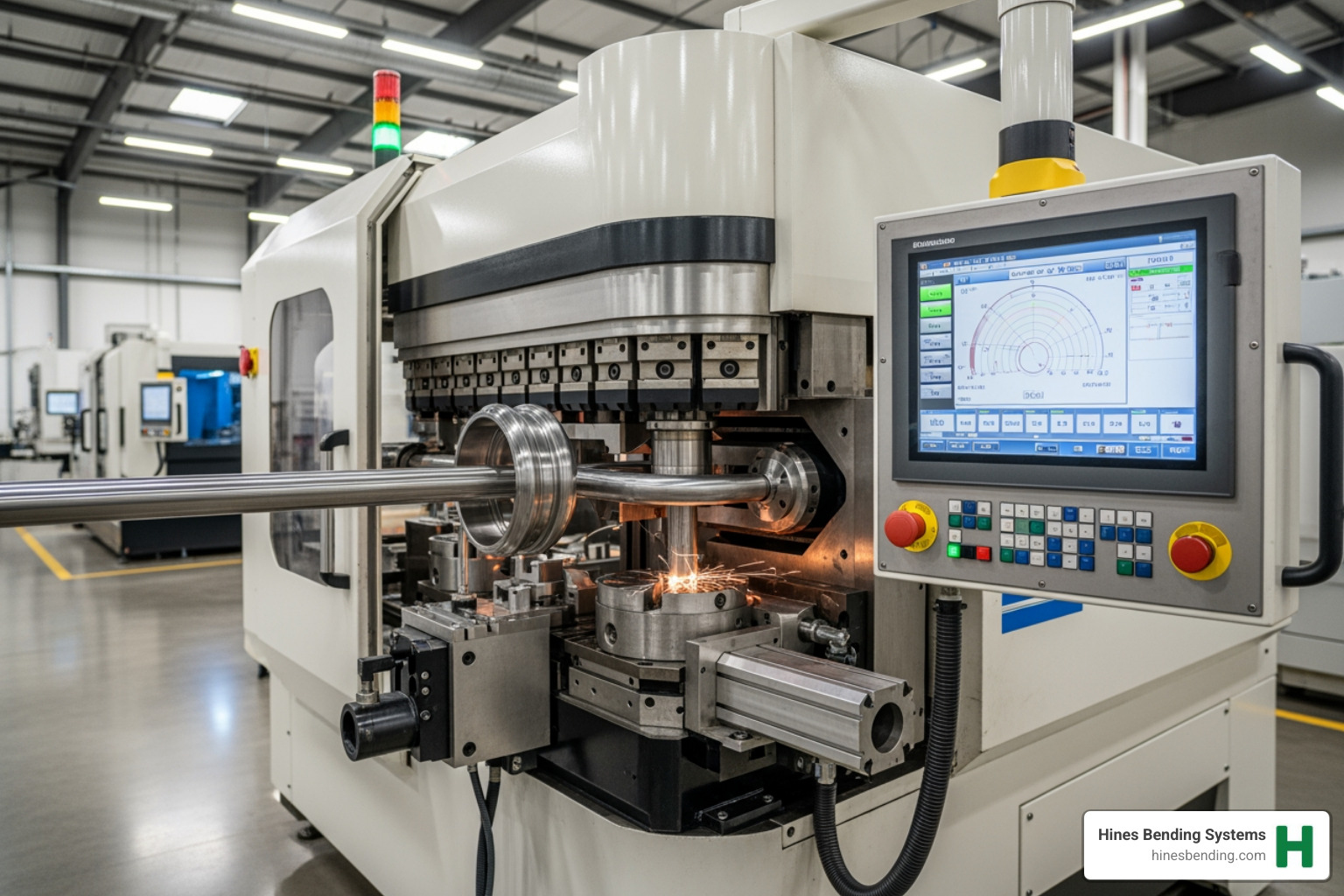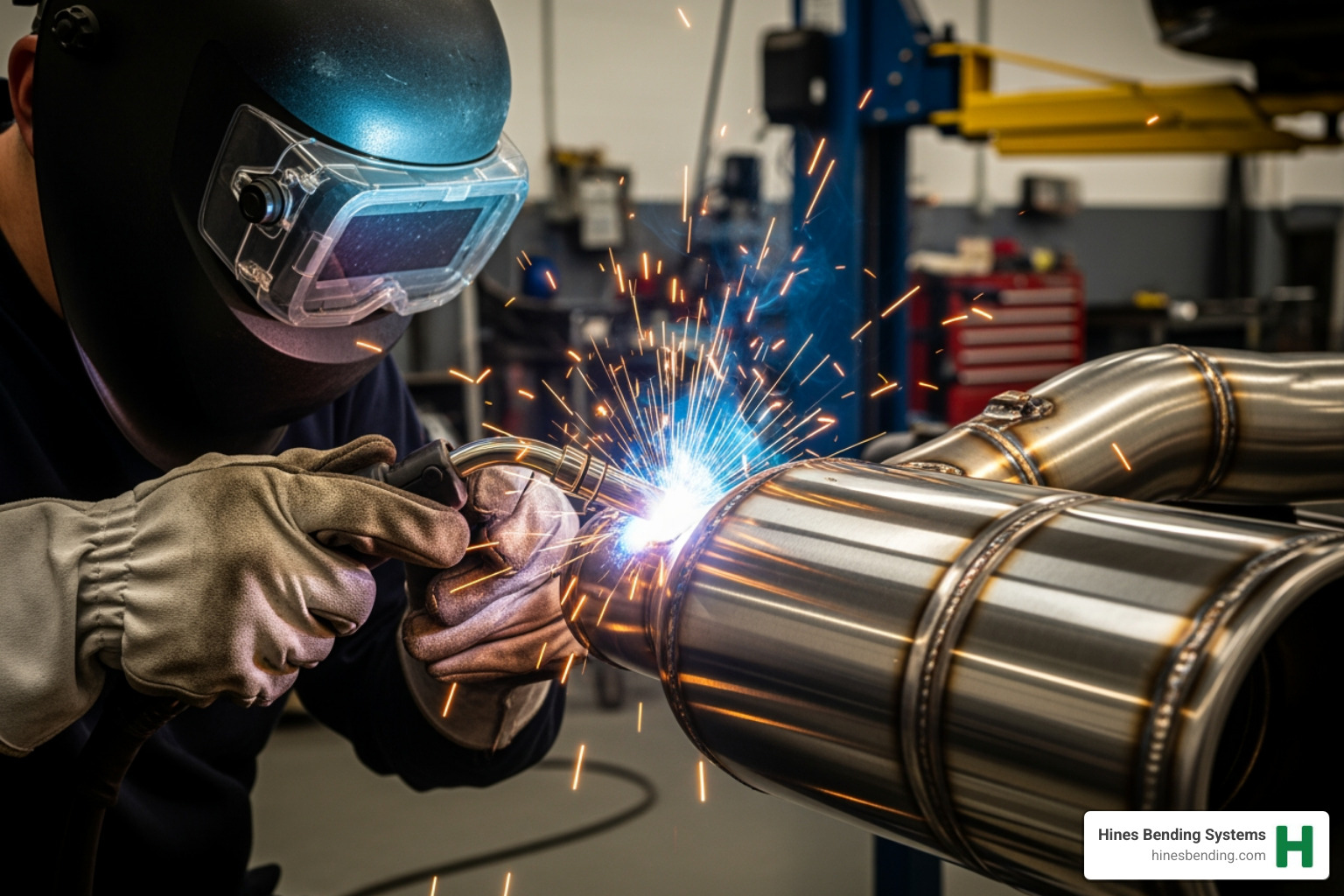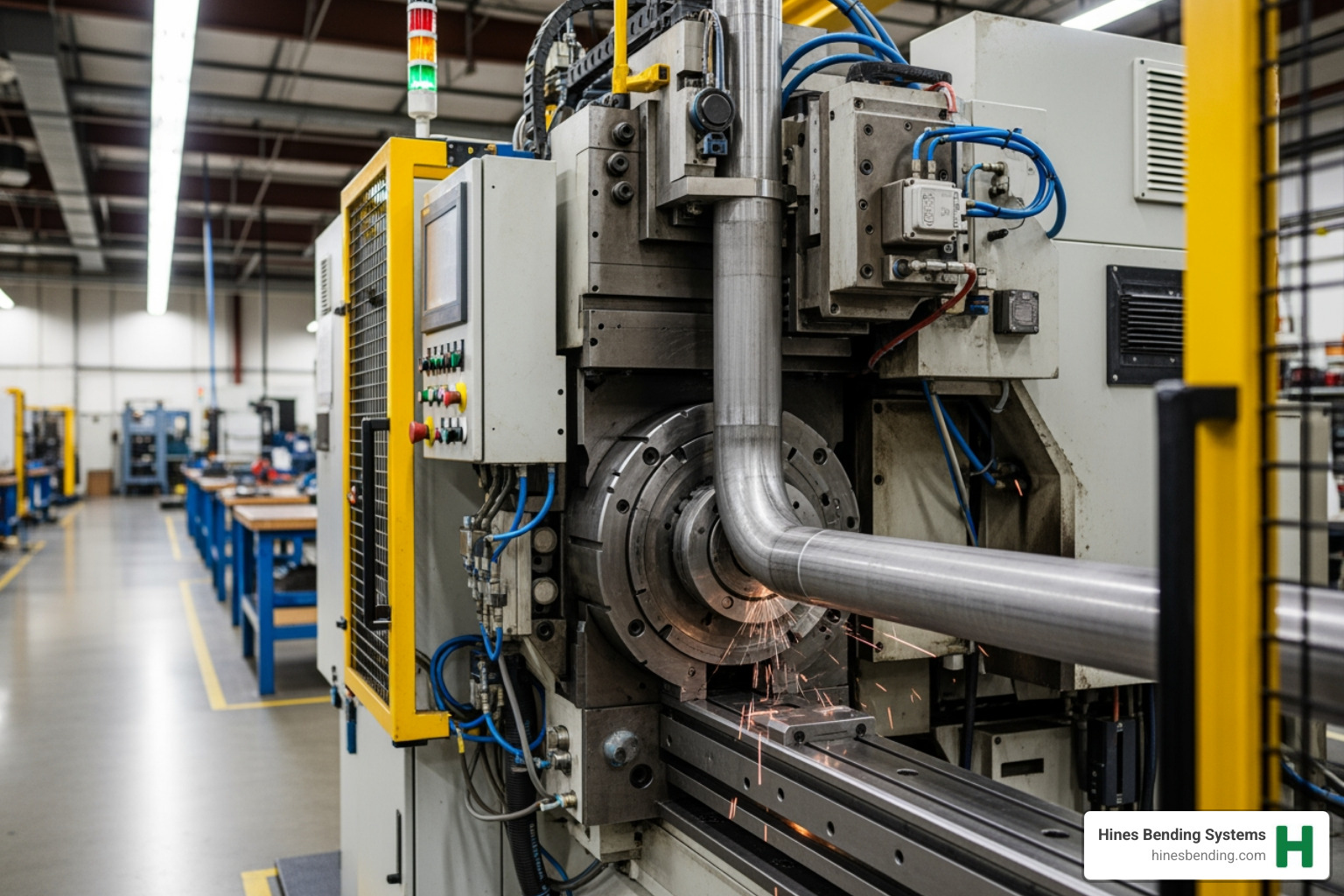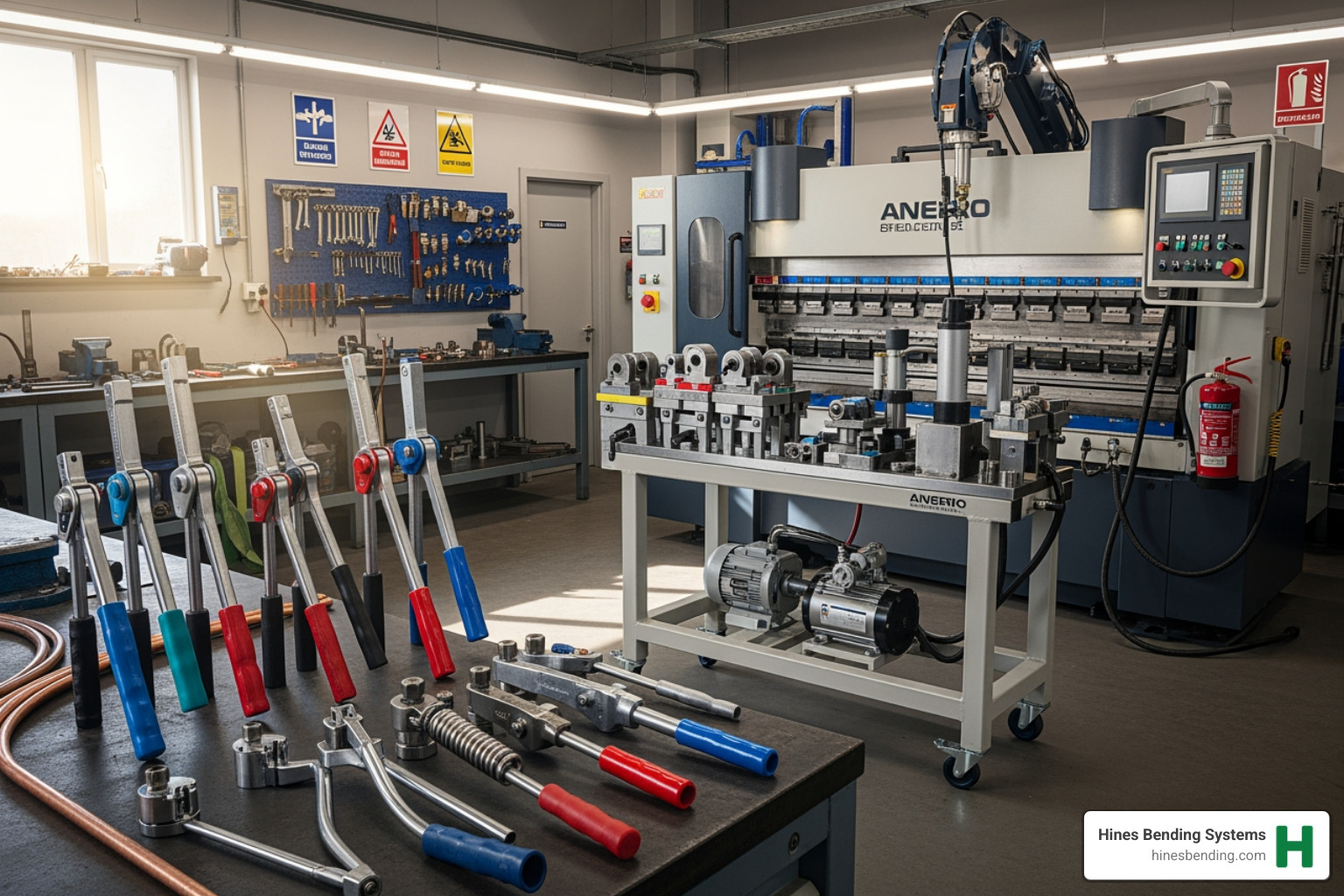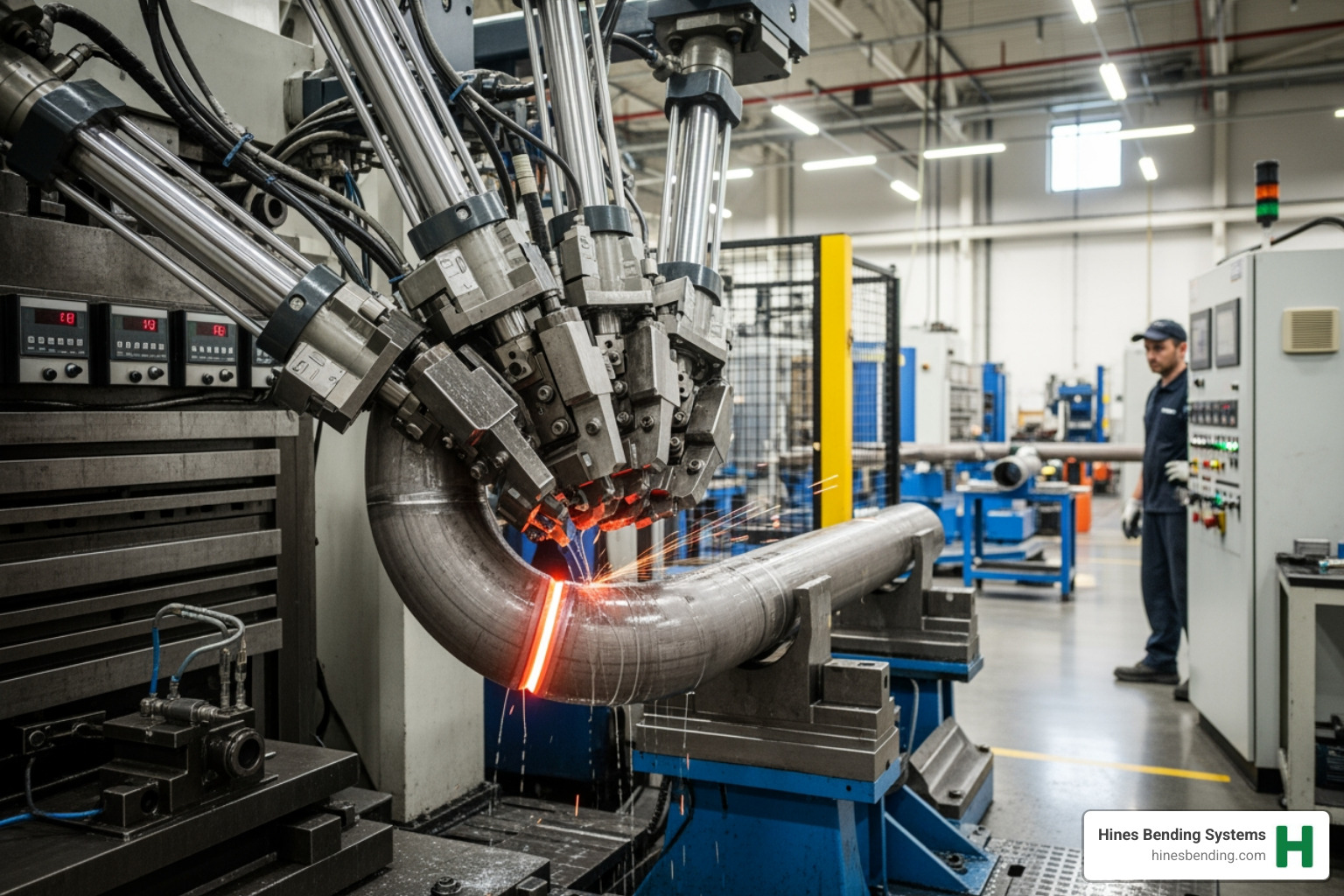Finding the Right Square Tube Bender for Your Project
A square tube pipe bender is specialized equipment designed to bend square metal tubing without excessive deformation, wall thinning, or collapse. For manufacturing operations managers looking for the most efficient bending solutions, here’s a quick overview of the top options:
| Bender Type | Best For | Price Range | Key Feature |
|---|---|---|---|
| Manual | Small projects, hobbyists | $140-$600 | Portability, low cost |
| Hydraulic | Medium production | $600-$2,000 | Higher force, less effort |
| CNC | High-volume production | $6,000-$30,000+ | Precision, repeatability |
| Roller | Large radius bends | $3,000-$15,000 | Continuous bending |
| Induction | Heavy-wall tubing | $50,000+ | Minimal deformation |
Square tube bending presents unique challenges compared to round pipe bending. The flat sides and corners of square tubing make it prone to deformation, wrinkling on the inside radius, and stretching at the outer corners.
Manufacturers like Hines Bending Systems have developed specialized solutions that overcome these challenges through precision engineering and advanced tooling. As the #1 worldwide manufacturer of tube and pipe benders, Hines provides custom bending solutions to clients ranging from small fabrication shops to NASA.
When selecting a square tube pipe bender, consider:
- Material: Wall thickness and grade affect bendability
- Bend radius: Tighter bends require more specialized equipment
- Production volume: Higher volumes justify CNC automation
- Tolerance requirements: Precision needs dictate machine quality
- Budget: Professional machines range from $500 to $30,000+
Unlike DIY options that may compromise quality, professional-grade square tube benders maintain the tube’s structural integrity throughout the bending process. This is critical for applications in automotive, aerospace, furniture manufacturing, and construction where safety and appearance both matter.

What Is a Square Tube Pipe Bender?
A square tube pipe bender is a specialized machine designed to form square metal tubing into curved shapes while maintaining the tube’s structural integrity. These machines apply controlled force to reshape metal tubing without causing excessive distortion or compromising the material’s strength.
As our experts at Hines Bending Systems often say, “Bending square tubing is a different animal compared to round pipe. The flat sides and sharp corners create unique challenges that require specialized equipment and expertise.”
Square tube benders typically employ one of several bending methods – rotary draw bending offers the most precision by using a bend die, clamp die, and pressure die to form the tube around a fixed point. Roll bending uses three or more rollers to progressively form the tube into a curve. Compression bending forces the tube against a stationary form die, while mandrel bending uses an internal support to prevent collapse during the process.
How a square tube pipe bender works
The mechanics behind a square tube pipe bender involve applying force to overcome the material’s resistance while controlling deformation. The process begins with securing the square tube in place using a clamping mechanism. Then, a die with the desired bend radius (centerline radius or CLR) is positioned properly.
When force is applied, the tube conforms to the die’s shape, experiencing compression on the inside of the bend and stretching on the outside. After releasing pressure, you’ll notice some “springback” where the tube partially returns toward its original shape – this is completely normal and accounted for in professional bending operations.
A key challenge in square tube bending is managing the forces that cause the tube’s walls to deform. The flat sides tend to buckle inward or bulge outward, while corners can stretch or collapse.
At Hines Bending Systems, we’ve developed proprietary tooling that addresses these challenges through precise die design and advanced mandrel technology. Our engineers work closely with clients to ensure the tooling matches the exact specifications of the material being bent.
Key differences between bending square vs round tubing
Bending square tubing presents several distinct challenges compared to round tubing. The flat sides of square tubing are prone to buckling or oil-canning (waviness) during bending. The outer corners experience significant stretching forces that can cause thinning or cracking if not properly supported.
Wrinkling on the inside radius often develops as material compresses, and the weld seam (where applicable) must be positioned correctly to prevent failure. Additionally, square tubing typically requires a larger minimum bend radius than round tubing of similar size.
One of our manufacturing clients, an operations manager from a major automotive component supplier, shared: “We struggled with consistent quality when bending square tubing for our chassis components until we upgraded to Hines’ specialized tooling. The difference in precision and repeatability was immediate.”
With decades of experience serving industries from aerospace to construction, Hines Bending Systems has perfected the art and science of square tube bending. Our NASA-trusted solutions ensure that whether you’re fabricating furniture frames or critical structural components, your square tube bends will maintain both strength and appearance.
Main Types of Square Tube Bending Machines
The world of square tube pipe benders is diverse, with each type offering unique advantages for specific projects and production needs. Whether you’re a weekend warrior or managing a high-volume manufacturing facility, Hines Bending Systems has developed customized solutions that lift your bending capabilities.

Manual square tube pipe bender
When you’re just starting out or handling occasional projects, a manual square tube pipe bender might be your perfect match. These entry-level workhorses use clever lever mechanisms to multiply your muscle power into impressive bending force.
These budget-friendly options typically range from $140-$600, making them accessible for hobbyists and small shops alike. Their compact footprint means you won’t need to reorganize your entire workspace, and since they don’t require electricity, you can set up shop practically anywhere.
Of course, there are trade-offs. Manual benders generally handle smaller tube dimensions and thinner walls, and your results will depend heavily on operator skill and technique. Still, for many fabricators, a quality bench-mounted die bender capable of handling 1″ to 3″ square tubing provides the perfect balance of affordability and capability.
“I started with a manual bender from Hines for my custom furniture business,” shares one small shop owner. “The quality of the bends was so consistent that my clients couldn’t tell my pieces from those made with industrial equipment.”
For reliable performance without breaking the bank, check out Hines Bending Systems’ Square Tubing Benders For Sale that deliver professional results even in manual operation.
Hydraulic & CNC solutions
When production demands increase, it’s time to consider stepping up to hydraulic or CNC square tube pipe benders that combine power with precision.
Hydraulic benders bring serious muscle to your bending operations, typically generating tons of force while reducing operator fatigue. At $600-$2,000 for basic models, they represent a reasonable upgrade path that pays dividends in consistency and capability. These semi-automated workhorses handle larger tube dimensions and thicker walls that would stymie manual benders.
For operations where precision and repeatability are non-negotiable, CNC benders shine brightest. With programmable controls that store complex multi-bend sequences, these machines deliver exceptional repeatability—often within ±0.05 mm. Their quick-change tooling systems slash setup times, while seamless data integration with production systems streamlines your entire workflow.
Yes, the initial investment is higher ($6,000-$30,000+), but many operations managers find the per-piece cost drops dramatically. As one aerospace component manufacturer finded after implementing a Hines CNC system: “We slashed our setup time by 65% and reduced scrap by over 80%. The machine paid for itself in under eight months.”
Explore Hines Bending Systems’ state-of-the-art CNC Bending Machines to find how their advanced controls can transform your production efficiency.
Roller and induction options
For specialized applications that push the boundaries of conventional bending, roller and induction technologies offer compelling solutions.
Roller benders excel at creating large-radius, continuous curves that would be challenging with other methods. Priced between $3,000-$15,000, these versatile machines can form long sections of tubing into gentle arcs or even spiral shapes with minimal deformation—ideal for architectural applications and large-scale fabrication.
At the cutting edge of bending technology, induction benders use electromagnetic heating to achieve what was once considered impossible: extremely tight-radius bends in heavy-wall square tubing with minimal distortion. While their premium price tag ($50,000+) reflects their specialized capabilities, for industries like oil and gas, power generation, and shipbuilding, the results justify the investment.
Hines Bending Systems has pioneered multi-stack tooling configurations that allow their machines to handle diverse production needs without time-consuming changeovers. Their proprietary induction technology represents the pinnacle of precision square tube bending, delivering results that maintain structural integrity even in the most demanding applications.
“What separates Hines from other manufacturers is their deep understanding of material behavior,” notes one veteran production engineer. “Their machines don’t just bend metal—they control the entire deformation process to maintain the tube’s integrity.”
Specifications & Capabilities You Should Know
When shopping for a square tube pipe bender, understanding the key specifications isn’t just helpful—it’s essential for getting the right machine for your specific needs.

Most fabricators I’ve spoken with tell me they wish they’d paid more attention to machine capabilities before making their purchase. The typical commercial square tube pipe bender handles outside diameters from about 1 inch (25.4 mm) up to 3 inches (76.2 mm), though Hines Bending Systems offers specialized machines that can tackle much larger dimensions.
Wall thickness capacity is another crucial factor, with standard machines handling from 0.065 inch (1.7 mm) to 0.125 inch (3.2 mm) for mild steel. When it comes to bend angles, you’ll want a machine offering a range from 0° to 190°—that extra 10° beyond 180° helps compensate for springback in the material.
The centerline radius (CLR) capabilities typically range from 1.0D to 3.0D (where D is the tube diameter), with tighter radii requiring more specialized equipment. And don’t overlook tonnage—the force required increases dramatically with tube size and wall thickness.
As one Hines Bending Systems engineer put it during a recent training session: “The relationship between material, wall thickness, and bend radius isn’t just a technical detail—it’s the difference between perfect bends and scrapped material. Pushing beyond a machine’s rated capacity is like trying to tow a yacht with a compact car—something’s going to break, and it won’t be pretty.”
Choosing the correct die & tooling
I can’t emphasize this enough: proper tooling makes or breaks your square tube bending operation. The die and associated components must be precisely matched to your specific material and application.
When selecting tooling, consider the material grade of your tubing—higher-strength alloys demand more robust tooling components. Seam placement is equally crucial; weld seams should typically be positioned at the neutral axis to prevent failure during bending.
The mandrel selection process deserves careful attention as this internal support prevents collapse during bending. Don’t skimp on lubrication either—it dramatically reduces friction and wear on both your expensive tubing and tooling investment. Finally, clamp pressure must be precisely calibrated to prevent slippage without deforming the tube.
Hines Bending Systems takes a refreshingly thorough approach to tooling design. As one production manager at an aerospace component manufacturer told me: “What really impressed us was how Hines insisted on analyzing an actual sample of our square tubing before designing the tooling. They measured everything down to the thousandth of an inch, including the exact weld seam location. That attention to detail eliminated the trial-and-error we’d experienced with previous vendors.”
For specialized tooling services that match your exact specifications, check out Hines Bending Systems’ tooling services page.
Mandrel vs non-mandrel for square tubes
Perhaps the most important decision you’ll make when bending square tubing is whether to use mandrel support. This choice affects everything from bend quality to production speed and cost.
Mandrel bending truly shines when you need to preserve the square profile during bending. It minimizes wall thinning on the outside radius and prevents collapse on the inside radius—critical for thin-wall tubing (typically under 0.083″) and tight-radius bends (under 2.5D). The trade-off? It’s a more expensive and somewhat slower process.
By contrast, non-mandrel bending offers faster production speeds and lower tooling costs. The setup and operation are simpler, making it ideal for applications where some deformation is acceptable. This approach works well for thicker-wall tubing and larger bend radii, such as in furniture frames and similar applications.
A Hines application engineer explained it perfectly during a recent demonstration: “Think of a cafeteria chair. The square tubing frame has slight deformation at the bends, but it doesn’t affect function or appearance. That’s non-mandrel bending at its best. But for that architectural railing in a luxury hotel lobby? You’ll want mandrel support for those perfect bends that will be scrutinized up close.”
For aerospace components, precision machinery, or high-end architectural features where perfect shape retention is non-negotiable, mandrel bending isn’t just preferred—it’s essential. Hines Bending Systems excels at helping customers determine whether their application requires mandrel support based on material specifications and end-use requirements.
For comprehensive bender instructions and guidelines, Hines provides detailed documentation through their Support Portal, ensuring you get the most from your investment.
Best Practices for Perfect Square Tube Bends
Achieving high-quality bends in square tubing isn’t just about having the right equipment—it’s about knowing how to use it properly. At Hines Bending Systems, we’ve refined these practices over decades of experience and thousands of installations worldwide. Let me share some insider tips that will help you achieve those perfect bends every time.

When setting up your square tube pipe bender, start with the fundamentals. Make sure your machine is level and properly anchored—even small misalignments can lead to inconsistent bends. Before loading any material, check that all your tooling is clean and free of debris. Those tiny metal chips from previous jobs can create imperfections in your new bends.
The relationship between your dies and tube dimensions is critical. As one of our engineers likes to say, “It’s like Goldilocks—everything needs to be just right.” Too loose, and you’ll get deformation; too tight, and you risk damaging both the material and the machine.
Weld seam alignment deserves special attention. The seam represents a potential weak point in your tube, and its placement can dramatically affect your results. “For square tubing, we typically recommend positioning the seam at the neutral axis—neither in compression nor tension during bending,” explains our lead application engineer. This simple adjustment can make the difference between a perfect bend and a failed one.
Dialing in the right pressure settings takes some finesse. Too little clamping pressure, and your tube will slip during bending; too much, and you’ll deform the tube before bending even begins. Hines bending machines feature calibrated pressure controls that eliminate this guesswork, allowing operators to achieve consistent results from the first bend to the last.
Don’t skip your quality checks after each bend. Measure your bend angle with a protractor or angle gauge, and check for wall thinning with an ultrasonic thickness gauge. Look closely for wrinkles on the inside radius—they’re often early warning signs of incorrect setup. Most importantly, verify that the square profile remains consistent throughout the bend. Even minor distortions can affect how the component performs in its final application.
Safety should never be an afterthought. Proper PPE includes safety glasses or a face shield, gloves to protect against sharp edges, steel-toed boots, and close-fitting clothing that won’t catch in the machinery. I’ve seen too many close calls when operators skip these basics—don’t be that person.
Regular maintenance ensures your square tube pipe bender will deliver consistent performance for years. Daily cleaning of tooling surfaces takes just minutes but prevents hours of troubleshooting later. Weekly lubrication of moving parts, monthly inspection of hydraulic systems, quarterly calibration checks, and annual comprehensive service will keep your machine running like new.
When problems do arise, knowing how to troubleshoot saves valuable production time. If you’re seeing wrinkles on the inside radius, try increasing mandrel support or using a larger bend radius. Wall thinning on outside corners? Consider reducing bend speed or using boost pressure. For tube flattening issues, verify you’ve selected the correct die or add mandrel support. Inconsistent bend angles often point to material variations or machine calibration issues.

At Hines Bending Systems, we believe that great equipment is just the beginning. That’s why we provide comprehensive training and ongoing support with every machine we sell. Our goal isn’t just to sell you a bender—it’s to make sure you have the knowledge and confidence to maximize its performance.
By following these best practices, you’ll achieve consistent, high-quality bends in square tubing that meet your exact specifications. And remember, whenever you encounter a challenge that seems impossible, our team of experts is just a phone call away. After all, nobody in the bending machine industry has more expertise and experience than Hines.
Pros & Cons of DIY Square Tube Pipe Bender Builds
For those considering a homemade solution, it’s important to understand both the benefits and limitations of DIY square tube pipe benders.
Advantages of DIY Benders:
– Cost savings (typically under $200 in materials)
– Customizable to specific project needs
– Educational experience in fabrication
– Immediate availability without lead times
– Pride in building your own tooling
Limitations of DIY Benders:
– Restricted capacity (typically limited to smaller tubing sizes)
– Inconsistent results between bends
– Limited precision and repeatability
– Safety concerns due to lack of engineered safeguards
– No warranty or support
– Time investment in design and fabrication
Many DIY enthusiasts have created functional square tube benders using readily available materials like standard pipe, steel plate, custom dies, and bearings. These homemade tools can be effective for occasional use in non-critical applications.
A popular example is the Homemade Square Tube Bender that uses a horseshoe-shaped flat bar to establish the bend radius, with a short section of square tube welded to form the die center. While ingenious, such designs typically lack the precision and repeatability of professional equipment.
As one fabricator who upgraded from a DIY solution to a Hines Bending Systems machine noted: “My homemade bender got me started, but the inconsistency became frustrating. Some bends would be perfect, others would collapse or wrinkle. The Hines machine delivers perfect bends every time—it’s like night and day.”
When to upgrade to a professional square tube pipe bender
There are clear indicators that it’s time to invest in a professional square tube pipe bender from a reputable manufacturer like Hines Bending Systems:
- Production Volume Increases: When you’re consistently bending multiple pieces per day
- Quality Requirements Tighten: When customers demand precise, repeatable results
- Material Costs Rise: When scrap from failed bends becomes costly
- Larger Tubing Needs: When projects require tubing beyond DIY capacity
- Time Becomes Critical: When setup and bending efficiency impact deadlines
- Safety Concerns: When the forces involved exceed DIY safety margins
The return on investment (ROI) for a professional bender can be surprisingly quick. Consider this calculation:
- Average scrap rate with DIY bender: 15% of material
- Material cost: $5 per foot
- Average project: 100 feet of tubing
- Projects per month: 5
- Monthly scrap cost: $375
- Professional bender cost: $6,000
- New scrap rate: 1%
- New monthly scrap cost: $25
- Monthly savings: $350
- ROI period: 17 months
Beyond the direct cost savings, professional equipment from Hines Bending Systems offers intangible benefits like improved customer satisfaction, ability to bid on more demanding projects, and reduced operator fatigue and frustration.
For those ready to upgrade, Hines Bending Systems offers a range of Steel Pipe Benders For Sale that can handle both round and square tubing with precision and reliability.
Frequently Asked Questions about Square Tube Pipe Bending
What minimum bend radius can I achieve without distortion?
When it comes to bending square tubing, achieving the perfect radius without distortion is something of an art form. The minimum bend radius you can achieve depends on several factors that work together – kind of like ingredients in a recipe.
For most applications, you can follow these general guidelines:
- With a mandrel supporting the tube: You can typically achieve a radius as tight as 1.5 times the tube width
- Without mandrel support: You’ll need to stay closer to 3.0 times the tube width
To put this in practical terms, if you’re working with 2″ square tubing and using a mandrel, you can usually achieve a clean 3″ centerline radius. That same tube without mandrel support would need about a 6″ radius to avoid significant distortion.
What makes Hines Bending Systems special is our ability to push beyond these conventional limits. Our engineering team has developed specialized techniques that allow for much tighter bends than competitors can achieve.
“We recently helped an aerospace client achieve a bend radius of just 1.2 times the tube width with minimal distortion,” shares one of our application engineers. “This breakthrough saved them from using expensive welded assemblies and simplified their manufacturing process considerably.”
How do I prevent wrinkles on thin-wall square tubes?
Those pesky wrinkles on the inside radius of a bend are the nemesis of quality fabrication work, especially with thin-wall square tubing. Fortunately, there are several effective techniques to keep your bends smooth and professional.
First, proper mandrel support is absolutely crucial. A well-fitted ball-type mandrel provides the internal reinforcement needed to prevent the walls from collapsing inward. Think of it as a backbone for your tube during the bending process.
Boost pressure is another valuable technique. By pushing additional material into the bend area, you compensate for the natural stretching that occurs on the outside of the bend. This balanced approach helps maintain wall thickness throughout.
Controlled bend speed makes a significant difference too. Slower, more deliberate bending allows the material to flow more evenly around the die, reducing stress concentrations that lead to wrinkling.
Don’t overlook weld seam placement – positioning the seam at the neutral axis (typically the side of the tube) keeps it from experiencing either maximum compression or tension.
“The key is preventing wrinkles before they form,” explains our bending specialist at Hines. “Once those wrinkles develop, they’re impossible to remove without compromising the tube’s integrity. The right tooling and technique prevent the problem entirely.”
Which lubricant works best for commercial square-tube bending?
Choosing the right lubricant for your square tube pipe bender is like selecting the right oil for a high-performance engine – it can dramatically affect your results and equipment longevity.
At Hines Bending Systems, we’ve tested countless lubricants across thousands of applications, and we recommend different options based on your specific material:
For mild steel tubing, a heavy-duty lithium-based grease or specialized tube-bending lubricant provides excellent results. These thicker formulations maintain a protective film even under high pressure.
When bending stainless steel, which is notorious for galling, molybdenum disulfide compounds or chlorinated oils work best. These specialized lubricants prevent the metal-to-metal contact that can damage both your tube and tooling.
For aluminum tubing, lighter petroleum-based lubricants are ideal. They provide the necessary slip without being so thick that they leave residue or mark the softer material.
In mandrel bending operations, we actually recommend using different lubricants for different components – typically a heavier formulation for the mandrel itself and a lighter option for external tooling.
“The right lubricant can be transformative,” notes our senior technician. “We’ve seen cases where simply switching to the appropriate lubricant reduced wall thinning by up to 15% while extending tool life threefold. That’s a tremendous return on a small investment.”
For high-volume production environments, Hines Bending Systems machines can be equipped with automated lubrication systems that apply precisely the right amount at exactly the right time. This not only ensures consistent results but also reduces waste and operator variability.
Conclusion
Choosing the right square tube pipe bender isn’t just about equipment—it’s about securing your reputation for quality and reliability. After exploring the intricacies of square tube bending, one thing becomes crystal clear: professional equipment makes all the difference between mediocre results and exceptional fabrication.
While DIY solutions might tempt you with their modest price tags, the precision and consistency that comes with Hines Bending Systems’ professional equipment simply can’t be matched. As a production manager who recently upgraded told us, “The difference was immediate—no more scrapped materials, no more inconsistent bends, just perfect results every time.”
What sets Hines apart? As the #1 worldwide manufacturer of tube benders, pipe benders, and induction benders, they bring best expertise to every project. Their engineering team doesn’t just sell machines—they develop relationships and custom solutions that perfectly align with your specific bending challenges.
“Square tubing presents unique challenges that require specialized approaches,” explains a Hines engineer. “The flat sides, sharp corners, and potential for deformation mean that generic bending solutions often fall short.” That’s why Hines works closely with each client to understand their exact requirements before recommending or designing a solution.
From small fabrication shops crafting furniture frames to NASA engineers developing aerospace components where failure isn’t an option, Hines Bending Systems has earned trust through decades of innovation and unwavering quality. Their commitment to excellence has established them as the gold standard in the industry.
The investment in a professional square tube pipe bender from Hines pays dividends through increased productivity, reduced material waste, and the ability to take on more demanding projects. As one longtime customer put it, “Our Hines bender opened doors to clients we couldn’t have served before. The precision and consistency gave us confidence to bid on high-spec projects we would have passed on previously.”
Whether you’re bending square tubing for automotive components, architectural features, or custom furniture, Hines Bending Systems offers the equipment, expertise, and ongoing support to ensure your success. Their machines aren’t just built to bend metal—they’re designed to build your business.
Ready to take your square tube bending capabilities to the next level? Visit Hines Bending Systems’ Square Tube Bending Machine page to explore solutions custom to your specific needs. With Hines at your side, perfect bends are just the beginning.

